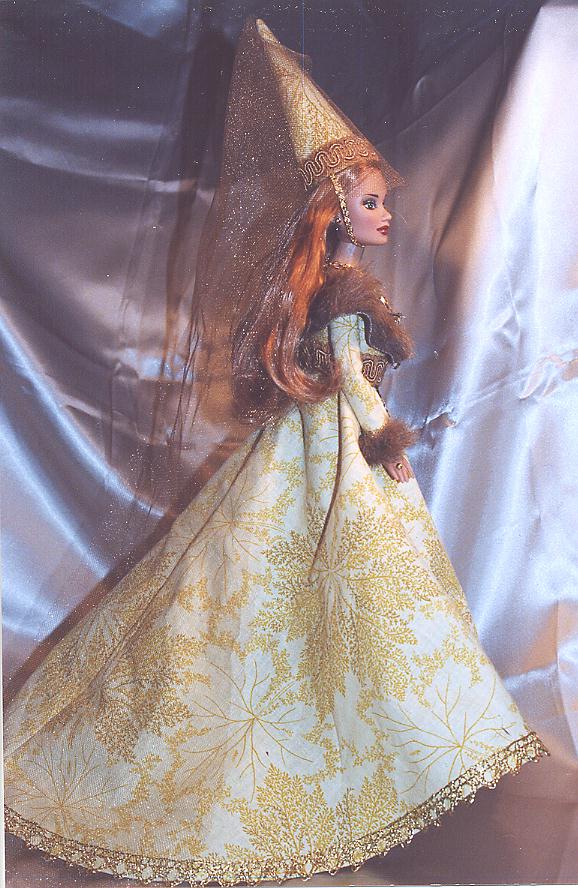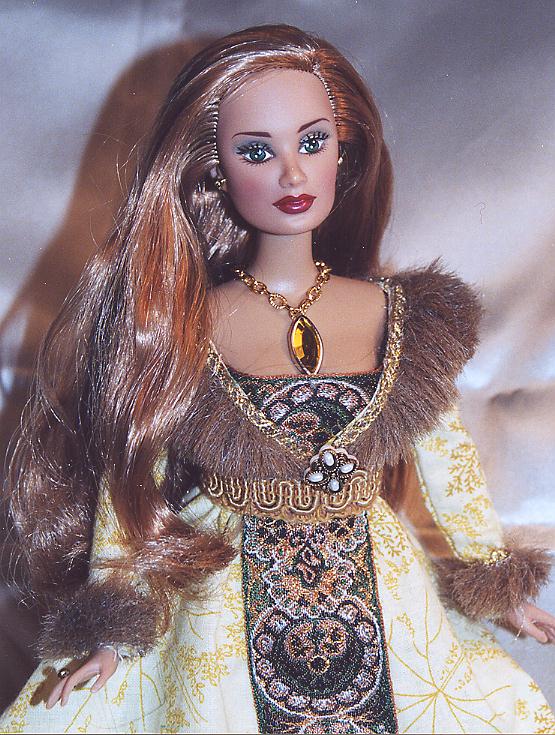 |
 |
 |
|
Ladie Faire Doll Designs
|
 |
 |
 |
|
Home | Medieval/Renaissance Designs | Antebellum "Belles" | Victorian and Edwardian Designs | Other Period Designs | Faerie/Fantasy Designs
|
 |
 |
|
15th OOAK Design:
Whoso list to hunt, I know where is an hind,
But as for me, alas, I may no more.
The vain travail hath wearied me sore
I am of them that farthest cometh behind.
Yet may I, by no means, my wearied mind
Draw from the deer, but as she fleeth afore,
Fainting I follow. I leave off therefore,
Since in a net I seek to hold the wind.
Who list her hunt I put him out of doubt,
As well as I, may spend his time in vain.
And graven with diamond in letters plain
There is written, her neck fair round about,
"Noli me tangere, for Caesar's I am,
And wild for to hold, though I seem tame."
--Sir Thomas Wyatt the Elder
1503-1542
(Need help with the language of this poem or want to know more about it?
See the bottom of this page.)
|
|
|
 |
 |
 |
 |
 |
 |
 |
|
| Autumnale |

|
The skirt is very full and flared, cut with a train at back; as the skirts were so long, women had to lift the front a bit
to walk, and in doing so, showed off underskirts just as rich as the overskirts, in complementary colors. Fur trim was fashionable
as well as the use of fancy embroidered, brocaded, and otherwise patterned materials for the gowns. . The rich fabrics and
jewelry of this ensemble suggest royalty or aristocracy.
| Autumnale |

|
Head-dresses for women in this period were their fashion-statement, having many different styles; they were, in fact, more
varied than dress-styles (see manuscript illustrations below for several examples). This doll wears a "steeple"
head-dress, or "hennin," with veil, a style thought to originate with Charles VI of France's queen, Anne of Bavaria;
it became popular in France and then in England.
|
|
 |
|
 |
 |
 |
 |
|
| Autumnale |

|
The outfit is in rich, autumnal tones which complement the doll's warm coloring. The gown and the hat are both of a sunny
gold material with intricate outlines of autumn leaves; the belt at the waist and the band of the hat are gold braid. A gorgeous
brocade ribbon in golds, greens, and browns forms the stomacher of the bodice and extends down the front of the skirt. Underneath
the gown (but not pictured) is an underskirt of antique-gold, "silk" cloth. The hem of the underskirt, the "V"
of the bodice, cuffs and neckline are trimmed in open-work gold ribbon, which also forms the band which holds on the hat.
Scalloped gold lace adorns the hem of the skirt, and fawn-colored "fur" trims the bodice and cuffs. Accessories
include a gold and pearl brooch on the bodice, a topaz "jewel" pendant on a gold necklace, gold ring and earrings.
Over the hat is draped a sumptuous veil of sparkling gold tulle.
The doll used with this design is an absolutely stunning "Alysa" doll; she is similar in height and shape to a Barbie
but with a slightly fuller figure and more chiseled features. She has a golden, tan complexion and long, tawny, amber hair.
Her face has received a partial repaint of the eyes--they are now a dark hazel-green, highlighted with subtle green and gold
shadow. The lips are the original russet color. She makes a beautiful, Provencal princess.
|
|
 |
 |
 |
|
 |
 |
 |
|

Here is my more modern gloss of the poem above; I tried to be fairly literal while still maintaining the same rhyme-scheme,
so it is not a word-for-word translation, but essentially the same in meaning:
Whoever wishes to hunt, I know where there is a doe,
but as for me, sadly, I cannot anymore.
This fruitless toil has tired me to the core
Farthest behind them all I follow,
Yet my weary mind I cannot withdraw,
at all, from the deer, but as she flees before,
exhausted, I chase her. I cease, therefore,
Since a net will not stop the wind's flow.
Whoever wishes to hunt her, my hint is not hidden,
Without a doubt he will waste his time like me
For engraved with diamonds in letters plainly seen
Around her fair neck there is written,
"Do not touch me, for to Caesar I belong,
And though I seem tame, you will not hold me for long."
This poem compares the pursuit of a woman's affection to the hunt--she is the doe (hind), and the poet is the hapless
hunter. Beyond the tiring pursuit of his love, the reference to Caesar complicates this proverbial hunt, as Caesar's deer
were supposedly given collars marked in this way so that they could then run free and not be hunted by anyone but him (the
phrase is borrowed from Petrarch). There is speculation that the poet was enamored of Anne Boleyn, who was courted by and
then married to Henry VIII--making the king the "Caesar" of this poem and she the tantalizing, but unattainable
doe.
|
|
 |
 |
 |











